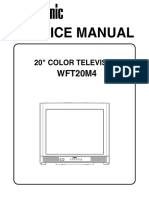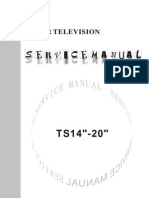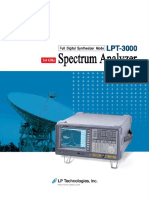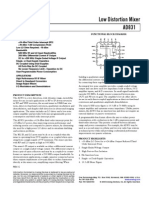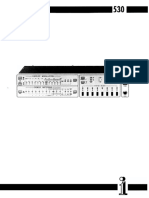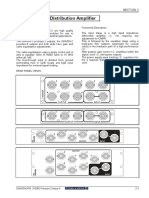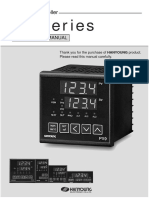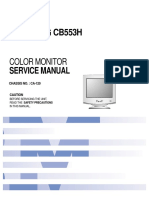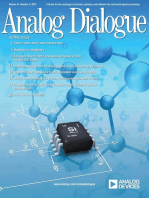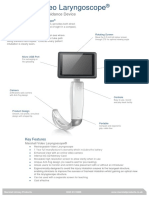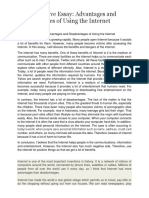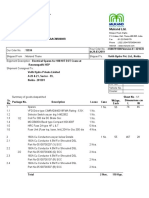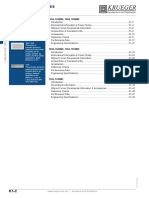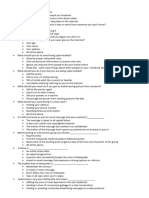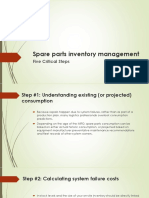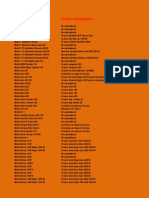TV & FM Level Meter: Prolink-1B
TV & FM Level Meter: Prolink-1B
Uploaded by
Vladimir FilkovCopyright:
Available Formats
TV & FM Level Meter: Prolink-1B
TV & FM Level Meter: Prolink-1B
Uploaded by
Vladimir FilkovOriginal Title
Copyright
Available Formats
Share this document
Did you find this document useful?
Is this content inappropriate?
Copyright:
Available Formats
TV & FM Level Meter: Prolink-1B
TV & FM Level Meter: Prolink-1B
Uploaded by
Vladimir FilkovCopyright:
Available Formats
PROLINK-1B INSTRUCTION MANUAL
TV & FM LEVEL METER
PROLINK-1B
1 GENERAL
1.1 Description
The PROLINK-1B is a professional, true portable, TV and FM Level Meter which
allows the measure of analogue and digital signals with a high degree of accuracy and
it is provided with advanced functions such as Video/Audio ratio measure, tunable audio
carrier, remote control and automatic start-up configuration. On the other hand, its
simple but powerful control procedure makes of it a really easy to use instrument.
It incorporates three different modes for the measure of analog signals: video, audio
and video to audio carrier rate. The measure is shown in a LCD alphanumeric display
and its presentation can be selected between numeric or analog, in the last case it is
shown by a bar graph.
The PROLINK-1B is equipped with a 30 dB RF attenuator, which enables the user
to measure signals of up to 120 dBµV with no need for additional external attenuators.
The frequency indication is carried out by a digital frequency meter and shown in an
alphanumeric display. The meter tuning bandwidth is from 47.25 up to 870 MHz. The
tuning can be continuous (frequency mode) with selectable 62.5 kHz or 1 MHz steps,
or by channel.
It is possible to select three different audio demodulators: FM, AM and Level Sound.
In the last mode the acoustical indicator emits a tone whose frequency varies with the
received power, this allows the user to find the peak signal without the need for
continuous observation on the display. Also it is possible to select two detection modes:
peak and average detection which allows the correct measure of digital or AM
modulated sound carriers.
It is also equipped with an RS-232C serial connector which permits the connection
to a personal computer for remote control and calibration purposes or the connection
to a serial printer for data dumping.
The device is powered by a rechargeable battery, which provides an autonomy for
about 3 hours (at 30% On/Off). To recharge the battery the meter is equipped with a
built-in charger that may be connected using an external AC/DC power adapter or a car
lighter plug. A LED in the front panel shows the battery charger operation .
September 1999 Page 1
PROLINK-1B INSTRUCTION MANUAL
1.2 Specifications
TUNING Digital frequency synthesis
Frequency mode Selectable 62.5 kHz or 1 MHz steps
Channel mode Up to 7 channel plans, each one with 126 channels
max. Channel plan configurable on demand
(OPT-101-61).
Frequency range From 48.25 to 870 MHz
Indication Frequency or channel by a 16 digits alphanumeric
display readout.
Resolution 62.5 kHz
Tuning accuracy ± 32 kHz
Memory One memory to store power-on configuration.
RF INPUT
Impedance 75 Ω
Connector BNC
Maximum signal 130 dBµV (3.16 V)
Maximum input voltage 60 V AC rms / 50-60 Hz
MEASUREMENT
Sensitivity
Low range (0 dB RF atten.) 30 dBµV to 90 dBµV
High range (30 dB RF atten.) 60 dBµV to 120 dBµV
Readout
Numeric Displayed in the alphanumeric display with 0.1 dB
resolution, with over-range and under-range
indication.
Analog Bar Graph Display
Acoustical Indicator A tone whose frequency varies with the signal level
RF Attenuators
10 dB RF Automatic attenuator, for low range measuring
scale.
30 dB RF Manual attenuator, for high range measuring scale.
Direct measurements accuracy ±2dB (0 dB attenuator, 20ºC ± 5ºC, 40 to 70% RH)
Attenuator accuracy ±1 dB (20 ºC ± 5 ºC, 40 to 70% RH)
SOUND
Demodulation FM, AM and Level Sound
Volume control
Built-in speaker
Page 2 September 1999
PROLINK-1B INSTRUCTION MANUAL
POWER SUPPLY
Internal 6 V - 1.2 Ah Lead Acid Battery
External
Measure 9 to 15 V DC
Bat. recharge 12 to 15 V DC
Autonomy 3 hours (at 30% on/off)
Recharging time About 10 hours (starting from a total discharge)
using an appropriate external power adapter.
Safety devices Low battery indication under 5.5 V
Consumption 7.2 W
OPERATING ENVIRONMENT CONDITIONS
Max. altitude 2000 m
Temperature range From 5 ºC to 40 ºC
Max. relative humidity 80% (up to 31 ºC)
decreasing lineally up to 50% at 40 ºC
MECHANICAL FEATURES
Dimensions W. 199.5 x H. 60.5 x D. 131.5 mm (without case)
Weight 1200 g (battery included)
ACCESSORIES INCLUDED
AD-050 BNC/m-ANT/f IEC adapter
AD-051 BNC/m -"F"/f adapter
AL-013 Europe and other countries 230 V / 50-60 Hz mains adapter
CB-039 6V 1.2 Ah lead acid rechargeable battery
0 PG4034 Carrier belt
DC-244 Carrying bag
OPTIONAL ACCESSORIES
RM-101 Control software
AL-023 USA and Canada 120 V / 50-60 Hz mains adapter
AA-012 Car supply adapter cable
AD-052 BNC/m-ANT/f (NF) Adapter
MC-75/300 75 Ω (BNC) / 300 Ω (TV) Impedance adapter
CV-550 5-50 MHz Sub-band converter
AT-20 20 dB Attenuator
LN-370B 20 dB Amplifier
NG-282 Noise Generator
CI-023 Portable serial printer
0 CA2040 RS-232 cable DB25/f-DB9/f
AMC/1 Reference antenna
September 1999 Page 3
PROLINK-1B INSTRUCTION MANUAL
OPTIONS
OPT-101-01 Replace mains adapter with U.S. AL-023
OPT-101-16 MMDS voltage supply
OPT-101-61 Programming of channel plan, measuring units, etc.
OPT-101-67 Extension of frequency range to cover the subband (5 to 45 MHz)
Page 4 September 1999
PROLINK-1B INSTRUCTION MANUAL
2 SAFETY RULES
* Use this equipment connected only to devices or systems with their common at
ground potential.
* This equipment can be used in Category I Installations and Pollution Degree 2
Environments.
* When using some of the following accessories use only the specified ones to
ensure safety.
Rechargeable battery
Mains adapter
Car supply adapter cable
* Observe all specified ratings both of supply and measurement.
* Remember that voltages higher than 60 V DC or 30 V AC rms are dangerous.
* Use this instrument under the specified environmental conditions.
* The user is only authorized to carry out the following maintenance operations:
Replace the battery
On the Maintenance paragraph the proper instructions are given.
Any other change on the equipment should be carried out by qualified
personnel.
* Follow the cleaning instructions described in the Maintenance paragraph.
September 1999 Page 5
PROLINK-1B INSTRUCTION MANUAL
* Symbols related with safety:
DIRECT CURRENT
ALTERNATING CURRENT
DIRECT AND ALTERNATING
GROUND TERMINAL
PROTECTIVE CONDUCTOR
FRAME TERMINAL
EQUIPOTENTIALITY
ON (Supply)
OFF (Supply)
DOUBLE INSULATION PROTECTED
(Class II Protection)
CAUTION
(Risk of electric shock)
CAUTION ( Refer to manual)
FUSE
Page 6 September 1999
PROLINK-1B INSTRUCTION MANUAL
3 INSTALLATION
The PROLINK-1B level meter is designed for use as a portable device powered by
a rechargeable battery. Before taking any measurement, the user should make sure that
the battery is charged.
3.1 Charging the battery
The PROLINK-1B is powered by a lead acid 6 V 1.2 Ah internal battery. If battery
charge is below 5.5 V, LOW BAT. message and current battery voltage will appear on
the LCD display, showing that it is necessary to recharge the battery. Also, a beep will
be heard.
The instrument is equipped with a 230 V / 50-60 Hz mains adapter (AL-013) for
Europe and other countries to power the battery charger. To request different adapters,
see 'Optional Accessories' in the specifications paragraph.
To fully recharge the battery, connect the device to the AC/DC mains adapter
through the [11] DC input (see figure 3). Connect then the adapter to the mains. Under
these circumstances the [6] BAT LED indicator on the front panel will be on. The length
of time it takes to recharge depends on the condition of the battery. If battery is very low
the recharging period will be about 10 hours with the unit turned off.
CAUTION
1) BEFORE USING THE CHARGER, MAKE SURE THAT THE ADAPTER IS
SUITABLE FOR THE MAINS VOLTAGE.
2) THE MAINS ADAPTER IS DESIGNED FOR INDOOR USE.
3) IF THE EQUIPMENT IS IN STORAGE OR IS USED ONLY OCCASIONALLY FOR
A LONG PERIOD OF TIME, IT IS ABSOLUTELY NECESSARY TO CARRY OUT
FULL-CHARGE OPERATIONS PERIODICALLY (EVERY SIX MONTHS, FOR
EXAMPLE) TO COMPENSATE THE SELF-DISCHARGING EFFECT OF THE
BATTERY.
September 1999 Page 7
PROLINK-1B INSTRUCTION MANUAL
Page 8 September 1999
PROLINK-1B INSTRUCTION MANUAL
4 OPERATING INSTRUCTIONS
4.1 Controls and Elements Description
Front Panel
Figure 1.- Front Panel.
[1] DISPLAY: 16 characters alphanumeric display. Indicates the level, the
tuned frequency or channel, the measurement mode, the sound
demodulation and the sound detection mode.
[2] TUNING: Rotary knob for tuning control.
[3] VOLUME, OFF: On/Off and Volume control.
[4] RF : RF signal input. BNC connector with an input impedance of
75 Ω.
Maximum input voltage level 130 dBµV or 60 V AC rms / 50-60 Hz
[5] RF ATT: 30 dB RF manual attenuator selector.
[6] BAT: LED indicator, it lights on when the battery charger is
connected.
September 1999 Page 9
PROLINK-1B INSTRUCTION MANUAL
Keyboard
Figure 2.- Keyboard
[7] LEVEL: By successive pushing this key, the different measuring modes for
analog channels are allowed: Video Level, Audio Level and
Video/Audio Level.
When pushing this key for more than one second the level readout
mode changes between Numeric Level and Bar Graph Level.
Pushed together with the [9] STEP key it selects the digital or
analog channels measuring mode.
Pushed together with the [8] SOUND it selects the print mode.
[8] SOUND: By pushing over it, the different sound functions are selected: FM,
AM and Level Sound.
Also, keeping this key pushed for more than one second, it
changes the sound detection mode between Peak Detector and
Average Detector.
When it is pushed together with the [9] STEP key, the equipment
stores the current configuration as start-up configuration.
In the print mode, when this key is pushed, the unit dumps to the
printer the information relative to the tuned channel.
[9] STEP: In the Channel Tuning Mode when this key is pushed the
instrument switches to Frequency Tuning Mode. Once in this mode
(Frequency Tuning mode) this key enables faster tuning by shifting
the minimum frequency step between 62.5 kHz and 1 MHz.
In the Frequency Tuning Mode it allows to return to Channel Tuning
Mode by keeping this key pushed for more than one second.
In the Channel Tuning mode, it permits to change to the next
channel plan stored in the unit (if available) by keeping it pushed for
more than one second.
In the print mode, when this key is pushed, the unit dumps to the
printer the information relative to the selected channels.
Page 10 September 1999
PROLINK-1B INSTRUCTION MANUAL
Side panel
Figure 3.- Side Panel
[10] RS-232C connector: Enables the remote control of the PROLINK-1B from a
personal computer with an optional software pack and
the data dumping to a printer.
[11] DC input for the mains adapter
September 1999 Page 11
PROLINK-1B INSTRUCTION MANUAL
4.2 Operating Instructions
4.2.1 Quick operation guide
1.- Power on the equipment by turning clockwise the [3] VOLUME/OFF control.
Figure 4.- Start-up
The display will show the PROLINK-1B version and the recorded initial configuration
in the following order:
Measure: Video, Audio or Video/Audio rate
Sound: FM, AM, or Level Sound
Level readout: Numeric or Bar Graph Level
Audio detection: Peak or Average
Tuning method: Frequency or Channel
Factory start-up configuration is marked with bold letters. These operation modes
can be modified and stored in order to replace the start-up configuration as it is
described in the following paragraphs.
When the PROLINK-1B is battery powered and except if battery is near to full
charge, the device automatically disconnects the display back-lighting one minute
after last control has been modified; when pressing any key it will light again
automatically. If battery voltage is low, the display back-lighting is deactivated in
order to increase the operation time in extreme conditions.
2.- Tune the desired frequency by means of the [2] TUNING control. To change to
Channel Tuning Mode see paragraph '4.2.2 Tuning'.
Page 12 September 1999
PROLINK-1B INSTRUCTION MANUAL
3.- The tuned frequency is shown on the right side of the display and the video carrier
level on the left side.
Figure 5 shows, as an example, the information that will appear as a result of tuning
a video carrier at 471.25 MHz with a level of 54.2 dBµV.
Figure 5.-
To select the bar graph level readout mode, see paragraph '4.2.3 Readout
presentation mode'. If the level is higher than 90 dBµV the 30 dB attenuator must
be selected by means of the [5] RF ATT key as described in paragraph '4.2.5
Setting the attenuators'.
4.- To change the sound demodulation mode to AM or Level Sound proceed as it is
described in paragraph '4.2.6 Audio demodulation and detection mode'. The [3]
VOLUME/OFF control allows to select the volume level.
5.- To select a different measuring mode: sound carrier level or Video/audio rate
proceed as described in paragraph '4.2.4.1 Measure of analog signals'.
6.- For measuring digital channels proceed as described in paragraph 4.2.4.2.
Following paragraphs describe the different operation modes of the PROLINK-1B.
To explain it several figures are used, arrows point to the key/s which must be pushed.
The indication 2 SEC means that the key must be pushed for more than one second.
Below the keyboard it is shown the message that will appear on the display when
selecting the new operation mode.
September 1999 Page 13
PROLINK-1B INSTRUCTION MANUAL
4.2.2 Tuning
The PROLINK-1B has two tuning modes:
1) Frequency Tuning, with selectable frequency step: 62.5 kHz or 1 MHz.
2) Channel Tuning.
In the Channel Tuning Mode by pushing the [9] STEP the unit switches to the
Frequency Tuning Mode as showed in figure 6.
Figure 6.- Frequency tuning mode
With the [2] TUNING rotary knob it is possible to tune the desired frequency.
In the Frequency Tuning Mode the [9] STEP key enables faster tuning by shifting
the minimum step between 62.5 kHz and 1 MHz in order to carry out substantial
changes in frequency. When the 1 MHz step is selected in the display appears the
symbol ^ at the left side of the tuned frequency as shown in figure 7.
Figure 7.- Frequency tuning, 1 MHz step indication.
Page 14 September 1999
PROLINK-1B INSTRUCTION MANUAL
In the Frequency Tuning Mode it is possible to change to Channel Tuning Mode
keeping pushed the [9] STEP key for more than one second.
Figure 8.- Channel Tuning Mode.
In the Channel Tuning mode it is possible to change to the next channel plan stored
in the unit by keeping pushed for more than one second the STEP [9] key. Active
channel plan is kept when switching between the channel and frequency tuning modes.
If present channnel plan and tuned channel are desired to be defined as power-on
tuning, present configuration must be stored in the power-on memory (to do this press
SOUND [8] and STEP [9] keys together).
4.2.3 Readout presentation mode
It is possible to select the level readout mode between Numeric Level or Bar Graph
Level by pushing the [7] LEVEL key for more than one second as show next figures.
LE VE L FREQ. MHz LE VE L FR EQ . M Hz
CHANNEL CHANNEL
Figure 9.- Setting Numeric Level readout mode.
September 1999 Page 15
PROLINK-1B INSTRUCTION MANUAL
LEVEL FREQ. MHz LEVEL FREQ. MHz
CHANNEL CHANNEL
Figure 10.- Setting the Bar Graph Level readout mode.
In the Bar Graph Level readout mode, the reference value (the left side of the
display) is 20 dBµV, and each display character corresponds to 10 dB.
4.2.4 Analog and digital channels measure
The PROLINK-1B enables the measure of analog and digital channels. To select
the measuring mode it is necessary to push the [7] LEVEL and [9] STEP keys together
as it is shown in figures 11 and 12.
Figure 11.- Analog signals measure.
Figure 12.- Digital signals measure.
Page 16 September 1999
PROLINK-1B INSTRUCTION MANUAL
4.2.4.1 Analog signals measure
In the measure of analog signals three different measuring modes can be selected:
Video, Audio and Video/Audio rate, to do this push the [7] LEVEL key. The measuring
mode selection is sequential as described in the following figure:
Figure 13.- Measuring modes.
Next it is explained the selection of the different measuring modes.
1) Video Carrier Measure, selects the level measure of the currently tuned
video carrier frequency.
Figure 14.- Video Carrier Measure Display.
2) Audio Carrier Measure, selects the level measure of the audio carrier
related to the tuned video carrier .
Figure 15.- Audio Carrier Measure Display.
September 1999 Page 17
PROLINK-1B INSTRUCTION MANUAL
3) Video/Audio Measure, selects the VIDEO/AUDIO rate measure.
Figure 16.- Video/Audio Rate Measure Display.
The Video to Audio rate is a signal quality test that relate to the picture being
delivered to the customer. The following specifications ensure that there is no
interference in the same or in the adjacent channel. Its physical meaning is shown in
next figure.
Figure 17.- Video to Audio rate.
Figure 18.- Measurement of the relative video to audio rate.
Although this process depends on the standard used, it is usual to consider that a
properly transmitted PAL channel should have a sound subcarrier 13 dB below the
video carrier.
Page 18 September 1999
PROLINK-1B INSTRUCTION MANUAL
In this mode, the audio carrier position can be modified with the TUNING [2] knob
from 0 to 10 MHz, in order to adapt the measure to any TV standard. This has two
important applications as described in the following paragraphs:
4.2.4.1.1 Measurement of the adjacent channel level
The user can obtain the rate of the video carrier amplitudes of two consecutive
channels as shown in the figure:
CVL1 - CVL2 (dB)
Figure 19. Measurement of the adjacent channel level
Differences of more than 3 dB between carriers of adjacent channels may cause
problems of interference in reception.
4.2.4.1.2 Qualitative C/N evaluation
The measurement of the carrier-to-noise ratio is a very important parameter to
define the quality of the received signal. With the PROLINK-1B it is possible to obtain
a qualitative evaluation of this parameter. To do this just select the average value sound
detection system and make a video/audio measurement, tuning the audio subcarrier at
a frequency where the readout will be maximum (this will correspond to the minimum
modulation content). If there is not an adjacent channel, the measurement will be done
out-of-channel; on the contrary, if there is an adjacent channel the most suitable point
is around 3.5 MHz from the video carrier. This measurement can be taken as a
reference value and by modifying the situation it is possible to deduce if the noise
increases or not.
September 1999 Page 19
PROLINK-1B INSTRUCTION MANUAL
4.2.4.2 Measure of digital channels power
The PROLINK-1B allows to measure the power associated to a 8 MHz digital
channel directly. To do this follow next procedure:
Select the Digital Channels Measuring Mode:
Figure 20.- Measuring Digital Channels Power
Then check that the bandwidth associated to the digital Channel is 8 MHz (in this
margin the signal level is maintained high). The instrument readout inside this margin
will correspond to the digital channel power (in dBµV).
Example
Imagine a digital channel with a central frequency of 400 MHz as it is shown in figure
21. Its frequency bandwidth is of 8 MHz (from 396 MHz to 404 MHz signal level is
maintained high).
Page 20 September 1999
PROLINK-1B INSTRUCTION MANUAL
Figure 21.- Digital channel.
The readout provided by the unit is directly the power of the digital channel:
77.2 dBµV.
Figure 22.- Digital channel.
4.2.4.2.1 Considerations about the measure of digital channels
When measuring channels with a bandwidth different to 8 MHz it will be necessary
to apply a numeric correction on the readout provided by the unit.
The numeric correction is the following:
POWER [dBµV] = READOUT [dBµV] + CF
Where:
POWER: Digital channel power in dBµV
READOUT: Readout provided by the PROLINK-1B in dBµV
CF: Correction Factor according to the following table :
September 1999 Page 21
PROLINK-1B INSTRUCTION MANUAL
Channel Bandwidth CF
6 MHz - 1.2 dB
7 MHz - 0.6 dB
9 MHz + 0.5 dB
Previous correction must be done because the PROLINK-1B measurement
bandwidth is 230 kHz and the unit is programmed to perform the corrections necessary
for 8 MHz channels (most habitual situation). Previous formula can be deduced using
the next figure:
Figure 23.- PROLINK-1B measurement.
Page 22 September 1999
PROLINK-1B INSTRUCTION MANUAL
First of all figure 23 shows the Digital Channel Power Spectral Density. The figure
just below displays the PROLINK-1B equivalent input filter. Finally the figure at the
bottom shows how measurement is made by the PROLINK-1B. The unit is programmed
at factory to show on the display the equivalent power for a 8 MHz channel bandwidth.
If channel spectral density is constant within the bandwidth, the ratio between the
measurement and the actual power will be:
POWER [W] = MEASUREMENT [W] X BW1 / BW2
where:
BW1: DIGITAL CHANNEL BANDWIDTH
BW2: 230 kHz, PROLINK-1B MEASUREMENT BANDWIDTH
and in logarithmic units it corresponds to:
POWER [dBµV] = MEASUREMENT [dBµV] + 10 log [BW1/BW2]
4.2.5 Setting the attenuators
When the [5] RF ATT key is resting the equipment detects automatically the
attenuator state and includes its active value in the displayed level.
In the measure of signals with a level higher than 90 dBµV it is necessary to select
the 30 dB manual attenuator to prevent the measuring circuits saturation. To do this, it
is necessary to push the [5] RF ATT key. Also in this mode the equipment automatically
detects the attenuator state and includes its active value in the displayed level.
4.2.6 Audio demodulation and detection mode
The [8] SOUND key permits to select the different sound demodulators of the
equipment (FM, AM and Level Sound) and the detection mode (Peak or Average).
To select the sound demodulator push the [8] SOUND key until the desired mode
will be showed in the display, the selection mode is cyclical as shown in the following
figure, so at most it will be necessary to push it twice.
September 1999 Page 23
PROLINK-1B INSTRUCTION MANUAL
Figure 24.- Audio demodulator selection.
Next, the different sound demodulation circuits that can be selected are explained
by showing the message which will appear in each case. In all of them it is possible to
select the volume with the [3] VOLUME/OFF control.
1) Sound FM: Selects the FM sound demodulator for the tuned frequency,
giving its output to the internal speaker.
Figure 25.- FM Sound Demodulator.
2) Sound AM: Selects the AM demodulator output.
Figure 26.- AM Sound Demodulator.
Page 24 September 1999
PROLINK-1B INSTRUCTION MANUAL
3) Level Sound: A single tone of frequency related to the current measured
input level is passed to the speaker.
Figure 27.- Level Sound Demodulator.
This feature facilitates the peak signal search by eliminating the need of continuous
observation of the instrument.
Also, keeping the [8] SOUND key pushed for more than two seconds, the instrument
switches between Peak Detector and Average Detector. The Average Detector is the
suitable detector to measure correctly digital sound and AM (standard L) modulations,
while the Peak Detector is the appropriate one for the measurements of FM
modulations. Next figures show the text that appears when selecting these options.
At all times, the display shows information concerning the detection system used
for measurement in accordance with the following:
a) Peak detector: normal decimal point.
b) Average value detector: hollow decimal point.
Figure 28.- Peak Detector Measure.
September 1999 Page 25
PROLINK-1B INSTRUCTION MANUAL
Figure 29.- Average Detector Measure.
4.2.7 Start-up configuration
To store the current configuration as a start-up configuration push the [8] SOUND
key together with the [9] STEP key.
Figure 30.- Storing the current Configuration.
4.2.8 Print mode
Connecting the PROLINK-1B to a serial printer it is possible to print the information
concerning to the tuned channel or to several channels previously selected. Proceed as
follows:
Page 26 September 1999
PROLINK-1B INSTRUCTION MANUAL
1.- Connect the unit to a serial printer through the RS-232C connector placed at the
side panel. PROMAX can supply the CI-23 portable serial printer.
In a case where the user opts for the connection to another serial printer, the
handshake used by the PROLINK-1B must be present. See point
4.2.8.1 Handshake and control lines.
2.- Power on the PROLINK-1B by turning clockwise the [3] VOLUME/OFF control. Turn
on the printer.
3.- Tune the desired frequency by means of the [2] TUNING rotary knob.
4.- Select the print mode. To do this push the [7] LEVEL (SELECT) and [8] SOUND
(PRINT) keys together as shown in figure 31. The upper row of the display
(SELECT, PRINT and LIST) refers to the available operations in this mode.
Figure 31.- Print mode selection.
In the display will appear the message PRINT MODE ON in order to confirm the
new operation mode.
5.- To print the information relative to the tuned channel, push the [8] SOUND (PRINT)
key, as shown in figure 32.
Figure 32.- Printing the tuned channel.
September 1999 Page 27
PROLINK-1B INSTRUCTION MANUAL
In measurement printing, fields appear to be filled in by the user in order to identify
the measurements. These fields are as follows:
LOCATION:
TEST P:
DATE:
TIME:
SIGNATURE:
If the unit is in the numeric level presentation mode, it will print the channel number,
the video carrier level (in dBµV) and the ratio Video/Audio.
On the other hand, if the unit is in bar graph presentation mode it will print a
representation on the power spectrum as shown in figure 33.
Figure 33.- Channel printing in bar graph presentation mode: spectrum function
The total sprectum bandwidth printed is of 10 MHz. The initial frequency printed is
2 MHz before the nominal frequency for analogue channels and 5 MHz for digital
channels. Divisions are of 1 MHz in frequency and 10 dB/div in level. The reference
level is 20 dBµV.
Page 28 September 1999
PROLINK-1B INSTRUCTION MANUAL
6.- Also it is possible to print the information concerning to several channels
automatically.
Previously it is necessary to select the channels we want to print. Tune the channel
using the rotary control [2] TUNING and next push the [7] LEVEL (SELECT) key.
When tuning a channel previously selected, letter p will appear on the right side of
the display as shown in figure 34.
Figure 34.- Selecting a channel and display indication.
To print the information concerning to the selected channels, push the [9] STEP
(LIST) key.
Figure 35.- Printing the selected channels.
If the unit is in numeric level presentation mode it will print, for each selected
channel, its number, video carrier level (in dBµV) and Video to Audio rate.
September 1999 Page 29
PROLINK-1B INSTRUCTION MANUAL
Figure 36.- Printing selected channels in numeric presentation mode.
On the other hand, if the unit is in bar graph presentation mode, it will print two bars
for each channel, one relative to the video carrier level and the other relative to the
audio carrier level as shown in figure 37.
Figure 37.- Printing selected channels in bar graph presentation mode.
7.- To exit the print mode repeat step 4. In the display will appear the message PRINT
MODE OFF.
Page 30 September 1999
PROLINK-1B INSTRUCTION MANUAL
4.2.8.1 Handshake and control lines
Next is described the handshake and control lines used by the PROLINK-1B:
- The following parameters are used for printing through the serial port:
Data bits: 8 bits
Parity: None
Baud-Rate: 19,200 bauds
Stop bits: 1
To modify the printer parameters see 4.2.8.2 CI-23 set-up.
- The control lines used are:
- DATA TRANSMIT (PROLINK-1B pin 3):
To send data to the printer.
- CLEAR TO SEND (PROLINK-1B pin 8) :
Data transfer control. Data are sent only when this line is active.
- DATA TERMINAL READY (PROLINK-1B pin 4)
This line is permanently active in order to indicate the establishment of
the communication.
Connections
The cable between the PROLINK-1B and the printer must have the following
connections:
September 1999 Page 31
PROLINK-1B INSTRUCTION MANUAL
Figure 38.- PROLINK-1B RS-232C connector. Pins numbering.
Page 32 September 1999
PROLINK-1B INSTRUCTION MANUAL
4.2.8.2 CI-23 Set-up
This point explains how to modify the CI-23 printer set-up. Figure 39 shows the
printer keyboard:
Figure 39.- CI-23 keyboard.
[1] POWER LED
[2] SET-UP
[3] FEED
[4] ON
[5] OFF
To initiate the set-up mode push the [2] SET-UP and the [4] ON keys. The
[1] POWER ON LED will flash until set-up mode is turned off. The current parameter
status will be printed. The status of the DATA BITS parameter will be printed in order
to modify it if necessary.
To select the status of the resting parameters (PARITY, BAUD-RATE, COUNTRY,
PRINT MODE, AUTO-OFF, EMULATION and DTR) push the [3] FEED key. The
parameters are selected in a sequential way. To modify the status of any parameter
push sequentially the [2] SET-UP key. Example:
SERIAL BAUD RATE: 300, 600, 1200, 2400, 4800, 9600, 19200, 300...
When all the necessary changes have been made, push the [2] SET-UP and [3]
FEED keys to update the configuration of the printer.
If no key is pressed for 15 seconds the set-up mode will be terminated without
changing the original parameters.
September 1999 Page 33
PROLINK-1B INSTRUCTION MANUAL
Page 34 September 1999
PROLINK-1B INSTRUCTION MANUAL
5 REMOTE CONTROL VIA A PC
5.1 Introduction
The design of PROLINK-1B, based on a microprocessor, allows data to be
exchanged between the equipment and a remote controller (personal computer) via an
RS-232C connector. It is thus possible to obtain data as well as remote control of the
PROLINK-1B (tuning, measurement, detection mode, etc) for maintenance purposes
and monitoring of installations.
5.2 Protocol for communication
This protocol is controlled by software and uses a RS-232C connector. Data and
information are exchanged using messages consisting of ASCII alphanumerical
characters. This method ensures easy carrying between different types of personal
computers.
To ensure error-free communication between the two devices, the communication
parameters of the series port must be selected on the Remote Controller (personal
computer) as described in section '4.2.8.1 Handshake and control lines'.
PROLINK-1B accepts remote commands at any time at which the instrument is on,
except when in print mode. That is, it is not necessary to put the instrument in a special
remote control mode; rather, this mode is selected immediately when it detects a
complete command during the time necessary for its execution.
In normal circumstance, PROLINK-1B transmits a XON code (code 11h) every
second. The aim is to indicate to any possible remote device that the equipment is
ready to receive data. The moment it receives a ' ' character indicating the start of a
*
remote command, the XON transmission stops and the echo of all the characters
received is returned until it receives a CR (carriage return, code 0Dh). At that moment,
PROLINK-1B understands that it has received a complete remote command, identifies
it and executes it. To indicate to the control equipment that it is in busy status, it sends
a XOFF (code 13h).
If the command received is identified as valid, an ACK (acknowledge, code 06h) is
transmitted and if not valid, a NAK (not acknowledged, code 15h) followed by a CR
(carriage return, code 0Dh) and an LF (line feed, code 0Ah).
If the command has been recognised as valid, it is executed and the required
response is returned (if the command so requires) followed by a new CR+LF.
September 1999 Page 35
PROLINK-1B INSTRUCTION MANUAL
A typical communication chronogram would be as follows:
PROLINK-1B PC (Controller)
XON ------>
• (at 1 second intervals)
•
•
XON ------>
<------ '*L0 + CR'
' L0' ------> (character echo until CR)
*
XOFF ------>
CR + LF ------>
ACK (validation)
•
• (execution)
•
• (optional response)
•
XON ------>
From the programmer's point of view, the control sequence passes through the
following status:
1) Wait to receive a XON
2) Send a complete command string, at the same time receiving the echo or
confirmation of each characters.
3) Send a CR.
4) Receive a XOFF as confirmation that a complete command has been received
and is being processed.
5a) Receive ACK as confirmation that a remote command has been recognised.
5b) Receive a NAK if the command has not been received (skip to status 8)
6) Receive CR+LF to allow the separation of the response line in terminal mode.
7) If the command is interrogative, the response is a string followed by CR+LF.
8) Once the command is completed, XON is sent. This is then repeated at 1
second intervals.
The special ' ' character always starts the receipt of a command. PROLINK-1B
*
interprets the character CR as the end of the command. Any character received
between these two codes is returned as an echo. The information received between
these two codes is interpreted as the command received.
Page 36 September 1999
PROLINK-1B INSTRUCTION MANUAL
In print mode, as the same port is used as for the data dump to the printer, all data
received is rejected and no XON character is transmitted until leaving this mode.
In the event an erroneous command is received, it is answered with a NAK code
instead of ACK and no execution or response phase is produced; instead it goes into
XON phase to wait for new data.
Commands should always be sent in capital letter and cannot be edited on-line, i.e.,
once a character is received it is stored in the PROLINK-1B buffer and cannot be
rectified by sending an erase code.
Commands in remote control are divided into two groups, orders and interrogations.
Order modify a variable or the equipment status. Interrogations respond with information
concerning equipment status or the value of a variable.
For interrogative command, it is necessary to add the character '?' after the ' '
character.
*
5.3 Remote orders
NOTE 1: The (') character should not be sent; it is only included in the description in
order to define the string that makes up the remote command.
NOTE 2: The values given in small letter are parameters that change in value
depending on the function to be executed. These values are always decimal
or hexadecimal ASCII characters. For example, to transmit the value "1", we
must send the hexadecimal code 31 the corresponds to this character.
Consult the text for acceptable value margins. The transmission of
erroneous parameters or contradictory information may cause PROLINK-1B
to stop operating correctly. In this case it is necessary to reset the
equipment by momentarily switching it off.
' *Bm' : Blocks the automatic control of the 10 dB attenuator. The 'm' parameter
must be 0 for automatic operation (usual value) and 1 to set the
attenuator position in the current status.
' *CF' Tunes the nearest channel to the tuned frequency
' *Cnnnn' Selects one channel of the active channel table. 'nnnn' is the
hexadecimal representation of the channel number (from 0 to 125 in
decimal notation).
' *FC' Changes from channel tuning mode to frequency tuning mode, tuning
the frequency of the last tuned channel.
September 1999 Page 37
PROLINK-1B INSTRUCTION MANUAL
' *Fxxxx' : Modifies the tuning frequency reprogramming a new value for the PLL.
The value of the PLL 'xxxx' must be sent in hexadecimal format,
according to the next expression:
xxxx = hexa value of [16(fin + 33,375)]
fin = input frequency in MHz
For example, calculating the divider for an input frequency of 655.25
MHz, would be:
fin + 33,375 = 688,625
16 (fin + 33,375) = 11018
xxxx = hexadecimal value of (11018) = 2B0A
command = '*F2B0A'
Four figures, including non-significant zeros must always be sent in the
PLL value.
' *Jsnn' Increases or decreases the tuned channel or frequency (it is equivalent
to turn the TUNING [2] rotary knob). Parameters follow the next rules:
's' + Increment
- Decrease
'nn' 01 < nn < 05 Moves one step
nn ≥ 5 Moves 10 steps in channel mode,
one step in frequency mode.
' *Lm' : Modifies the active measurement mode. The 'm' parameter corresponds
to the election value for the 'LEVEL' function of the keyboard, in
accordance with the following:
0: measurement LEVEL VIDEO
1: measurement LEVEL AUDIO
2: measurement LEVEL VIDEO/AUDIO
' *Mn' : Selects the measurement mode between analogue or digital. The valid
values for the 'n' parameter are: 0: Analogue channels
1: Digital channels
' *Pm' : Selects the detector used in the audio level measurement. Valid values
for the 'm' parameter are: 0: Selects the peak detector
1: Selects the average detector
' *Qm' : Selects the active channel plan between one of channel plans stored
in the unit (7 maximum). Valid values for the 'm' (channel plan)
parameter are: 0, 2, 3, 4, 5, 6, and 7.
Page 38 September 1999
PROLINK-1B INSTRUCTION MANUAL
' *R' : Recuperates the power-up configuration established by 'SAVE'. Has no
parameters.
' *S' : Establishes the current configuration as the power-up configuration. Has
no parameters.
' *Txxxx' : Shifts the sound carrier with respect to the video carrier. This shift is
that applied in the LEVEL AUDIO and LEVEL VID/AU measurements.
The 'xxxx' value corresponded to the positive increment over the
current PLL divider which must shift the tuning to include the sound
carrier.
For example, for a sound carrier shifted 5.50 MHz with respect to the
video carrier (G standard), the value is calculated by dividing this
frequency by the minimum synthesis step (62.5 kHz):
5.50 MHz / 62.5 kHz = 88
xxxx = hexadecimal value of [88] = 0058
It is always necessary to send four figures included the non-significative
zeros.
' *Um' : Establishes the active sound mode associated with the 'SOUND'
function. Valid values of the 'm' parameter are:
0: selection of SOUND FM
1: selection of SOUND AM
2: selection of SOUND LEVEL
' *Xm' : Allows switching of the 10 dB attenuator status in accordance with the
value of the 'm' parameter. The 0 value turns the attenuator OFF (0 dB)
while the 1 value turns it ON (10 dB).
September 1999 Page 39
PROLINK-1B INSTRUCTION MANUAL
Command Action
B0 Automatic operation of 10 dB attenuator
B1 Blocks position of 10 dB attenuator
CF Tunes the nearest channel to the tuned frequency
Cnnnn Selection of one channel of the active channel table
FC Changes from channel tunning mode to frequency mode
Fxxxx Modifies the tuning frequency
Jsnn Increases / decreases the channel / the frequency
L0 Moves to VIDEO measurement
L1 Moves to AUDIO measurement
L2 Moves to VIDEO/AUDIO measurement
M0 Analogue measuring mode selection
M1 Digital measuring mode selection
P0 Selects the peak detection system for the sound measurement
P1 Selects the average detection system for the sound measurement
Qm Selects the channel plan (m: 0, 2, 3, 4, 5, 6, 7)
R Recalls power-up configuration
S Establishes power-up configuration
Txxxx Shifts sound carrier
U0 Selects FM sound demodulator
U1 Selects AM sound demodulator
U2 Selects sound LEVEL demodulator
X0 Disables 10 dB attenuator
X1 Enables 10 dB attenuator
Table II.- Remote commands
Page 40 September 1999
PROLINK-1B INSTRUCTION MANUAL
5.4 Remote interrogations
' *?&xx' : Returns the value contained in certain internal variables of
PROLINK-1B. These variables are addressed with a byte and return a
byte. The address value and the returned value are always
hexadecimal. Not all equipment variables make sense for the
programmer. The main purpose is for reading the buffer that appears
on the display. This buffer contains the corrected level reading and the
frequency or channel tuned to. As this information is expressed in
ASCII characters, it is easily interpreted by an external programmer.
Some useful addresses are (hexadecimal values):
18: high byte of PLL divider
19: low byte of PLL value
20 to 2F: 16 characters of the LCD display (from left to right)
For example we can determine if there is overflow or underflow by
reading the first characters of the displayed buffer: '*?&20'+CR+ LF'.
The response is: '*yy'
If the 'yy' code is the ASCII character for the '<' or '>' characters (3Ch
and 3Eh, respectively), this indicates that we are outside the
equipments measurement margins.
' *?Am' : Returns the level at the A/D converter input or at the display. The 'm'
parameter can have the following values:
1: average detector measurement
6: peak detector measurement
8: display content (corrected level, measuring units and
channel or frequency).
The average detector is used in the measurement of AM modulated
sound carriers (L standard) or digital carriers as is the case with NICAM
sound or QPSK or QAM modulations.
The values read are not corrected not compensated by temperature.
There they can only be used as a qualitative measurement of the input
signal. For example, for channel search.
The code returned corresponds to a voltage between 0 and 4.095V.
Codification is hexadecimal.
September 1999 Page 41
PROLINK-1B INSTRUCTION MANUAL
For example: '*?A6' + CR
with a response: '*A60237'
The '0237' value corresponds to 567 in decimal, which is the value in
millivolts of the input voltage (0.567 V). The approximate value
corresponding to the input level in dBs can be determined by
multiplying this voltage by a factor of 23 and adding an offset value of
some 15 dB. Thus we have:
approx. dB = 0.567*23 + 15 = 28 dB.
' *?B' : The response to this command is to block the 10 dB attenuator
'*B0': indicates the attenuator is in automatic mode.
'*B1': indicates that the attenuator is blocked.
' *?C' Returns the tuned channel in hexadecimal notation
' *?F' Returns the PLL divider value in hexadecimal notation
' *?M' Returns the measurement mode. The answer is '0' for analogue mode
and 1 for digital mode.
' *?P' Returns detection system used in the sound measurement. '0': peak
detector. '1': average detector.
' *?Q' Returns active chanel plan (possible responses are : 0, 2, 3, 4, 5, 6 and
7).
' *?X' : This command returns the status of the 10 dB and 30 dB attenuators.
Possible responses are:
'*X00': 30 dB and 10 dB attenuators disabled (attenuation is 0 dB).
'*X01': 30 dB attenuator disabled and 10 dB attenuator enabled
(attenuation is 10 dB).
'*X30': 30 dB attenuator enabled and 10 dB attenuator disabled
(attenuation is 30 dB).
'*X31': 30 dB and 10 dB attenuators enabled (attenuation is 40 dB).
' *?V' : Responds with a string identical to that shown on powering up the
equipment. In this set of characters you can read the model and the
version of the control program. Its mains use is to detect the presence
of PROLINK-1B and determine the software version.
Page 42 September 1999
PROLINK-1B INSTRUCTION MANUAL
Command Action
?&xx Returns the value contained in certain internal variables of PROLINK-1B
?A1 Returns the input level of the A/D converter (average detector)
?A6 Returns the input level of the A/D converter (peak detector)
?A8 Returns the display content
?B Returns the blocked status of the 10 dB attenuator
?C Returns the tuned channel
?F Returns the value of the PLL divider
?M Returns the measurement mode: analogue or digital
?P Returns the detection system used in the sound measurement
?Q Returns the number of the actual channel plan
?V Returns the model and version of the control program
?X Returns the status of the 10 dB and 30 dB attenuators
Table III.- Remote interrogations
September 1999 Page 43
PROLINK-1B INSTRUCTION MANUAL
Page 44 September 1999
PROLINK-1B INSTRUCTION MANUAL
6 MAINTENANCE
6.1 Replacing the battery
The battery must be replaced when the capacity of the fully-charged battery is
appreciably reduced.
To install the battery, follow these steps:
Figure 40.- Installing the battery
1 - Turn off the instrument.
2 - Remove the 4 attachment screws (A) which are positioned in the laterals of the
device.
3 - Remove the instrument top lid.
4 - Remove the two screws (B) which close the battery compartment.
5 - Disconnect the battery terminals and replace it with a new one. (CB-039 reference).
Take care with the polarity (red positive, black negative) of the terminals.
6 - Close the battery compartment and replace the two screws (B). Replace the
instrument top lid and attach it with the corresponding screws (A).
September 1999 Page 45
PROLINK-1B INSTRUCTION MANUAL
WARNING
Avoid any type of short circuit among the cables connected to the battery, since the
resulting high current may cause serious damage to the instrument.
6.2 Cleaning recommendations
CAUTION
TO CLEAN THE COVER, TAKE CARE THE INSTRUMENT IS DISCONNECTED.
CAUTION
DO NOT USE SCENTED HYDROCARBONS OR CHLORIZED SOLVENTS. SUCH
PRODUCTS MAY ATTACK THE PLASTICS USED IN THE CONSTRUCTION OF THE
COVER.
The cover should be cleaned by means of a light solution of detergent and water
applied with a soft cloth.
Dry thoroughly before using the system again.
Page 46 September 1999
PROLINK-1B INSTRUCTION MANUAL
TABLE OF CONTENTS
1 GENERAL . . . . . . . . . . . . . . . . . . . . . . . . . . . . . . . . . . . . . . . . . . . . . . . . . . . 1
1.1 Description . . . . . . . . . . . . . . . . . . . . . . . . . . . . . . . . . . . . . . . . . . . . . . 1
1.2 Specifications . . . . . . . . . . . . . . . . . . . . . . . . . . . . . . . . . . . . . . . . . . . . 2
2 SAFETY RULES . . . . . . . . . . . . . . . . . . . . . . . . . . . . . . . . . . . . . . . . . . . . . . 5
3 INSTALLATION . . . . . . . . . . . . . . . . . . . . . . . . . . . . . . . . . . . . . . . . . . . . . . . 7
3.1 Charging the battery . . . . . . . . . . . . . . . . . . . . . . . . . . . . . . . . . . . . . . . 7
4 OPERATING INSTRUCTIONS . . . . . . . . . . . . . . . . . . . . . . . . . . . . . . . . . . . . 9
4.1 Controls and Elements Description . . . . . . . . . . . . . . . . . . . . . . . . . . . . 9
4.2 Operating Instructions . . . . . . . . . . . . . . . . . . . . . . . . . . . . . . . . . . . . . . 12
4.2.1 Quick operation guide . . . . . . . . . . . . . . . . . . . . . . . . . . . . . . . . . 12
4.2.2 Tuning . . . . . . . . . . . . . . . . . . . . . . . . . . . . . . . . . . . . . . . . . . . . . 14
4.2.3 Readout presentation mode . . . . . . . . . . . . . . . . . . . . . . . . . . . . . 15
4.2.4 Analog and digital channels measure . . . . . . . . . . . . . . . . . . . . . . 16
4.2.4.1 Analog signals measure . . . . . . . . . . . . . . . . . . . . . . . . . . . . 17
4.2.4.1.1 Measurement of the adjacent channel level . . . . . . . . . 19
4.2.4.1.2 Qualitative C/N evaluation . . . . . . . . . . . . . . . . . . . . . . 19
4.2.4.2 Measure of digital channels power . . . . . . . . . . . . . . . . . . . . 20
4.2.4.2.1 Considerations about the measure of digital channels . . 21
4.2.5 Setting the attenuators . . . . . . . . . . . . . . . . . . . . . . . . . . . . . . . . . 23
4.2.6 Audio demodulation and detection mode . . . . . . . . . . . . . . . . . . . . 23
4.2.7 Start-up configuration . . . . . . . . . . . . . . . . . . . . . . . . . . . . . . . . . . 26
4.2.8 Print mode . . . . . . . . . . . . . . . . . . . . . . . . . . . . . . . . . . . . . . . . . . 26
4.2.8.1 Handshake and control lines . . . . . . . . . . . . . . . . . . . . . . . . 31
4.2.8.2 CI-23 Set-up . . . . . . . . . . . . . . . . . . . . . . . . . . . . . . . . . . . . 33
5 REMOTE CONTROL VIA A PC . . . . . . . . . . . . . . . . . . . . . . . . . . . . . . . . . . . 35
5.1 Introduction . . . . . . . . . . . . . . . . . . . . . . . . . . . . . . . . . . . . . . . . . . . . . . 35
5.2 Protocol for communication . . . . . . . . . . . . . . . . . . . . . . . . . . . . . . . . . . 35
5.3 Remote orders . . . . . . . . . . . . . . . . . . . . . . . . . . . . . . . . . . . . . . . . . . . 37
5.4 Remote interrogations . . . . . . . . . . . . . . . . . . . . . . . . . . . . . . . . . . . . . . 41
6 MAINTENANCE . . . . . . . . . . . . . . . . . . . . . . . . . . . . . . . . . . . . . . . . . . . . . . 45
6.1 Replacing the battery . . . . . . . . . . . . . . . . . . . . . . . . . . . . . . . . . . . . . . 45
6.2 Cleaning recommendations . . . . . . . . . . . . . . . . . . . . . . . . . . . . . . . . . . 46
You might also like
- Wiring Diagram ISB CM2150 and ISB CM2150 E: Engine Control ModuleDocument1 pageWiring Diagram ISB CM2150 and ISB CM2150 E: Engine Control ModuleOmar Hernández100% (2)
- User's Manual Mizar v2.0 50w FM TransmitterDocument47 pagesUser's Manual Mizar v2.0 50w FM Transmitterdiego pachon0% (1)
- Pentax EPK-p Video Processor Service ManualDocument15 pagesPentax EPK-p Video Processor Service Manualrafab6970100% (1)
- UniproVoIPUserGuide PDFDocument88 pagesUniproVoIPUserGuide PDFVladimir FilkovNo ratings yet
- AD831-MIXER 200-500MHzDocument17 pagesAD831-MIXER 200-500MHzChelaru CosminNo ratings yet
- IBU2000 Manual Ver 1.02Document9 pagesIBU2000 Manual Ver 1.02Amar AlgerNo ratings yet
- Onkyo - TXSV515PRO Service ManualDocument24 pagesOnkyo - TXSV515PRO Service Manualpatricks4431No ratings yet
- Disney dt1300-c PDFDocument50 pagesDisney dt1300-c PDFMikeNo ratings yet
- Generador Escort Egc3235aoprDocument30 pagesGenerador Escort Egc3235aoprJonh G. GonzálezNo ratings yet
- Symphonic Wft20m4Document49 pagesSymphonic Wft20m4XNicolasx XGomezxNo ratings yet
- Sylvania Srt2232x Service ManualDocument56 pagesSylvania Srt2232x Service ManualIgnatius ReillyNo ratings yet
- Datasheet - Nexus Conditioning Amplifier for Very High Input Types 2692-C and 2692-D (BP1976)Document4 pagesDatasheet - Nexus Conditioning Amplifier for Very High Input Types 2692-C and 2692-D (BP1976)Raviteja KumarNo ratings yet
- DN60 User ManualDocument29 pagesDN60 User ManualJens MortensenNo ratings yet
- Function GeneratorDocument37 pagesFunction GeneratorRoberto Angel Lora MartinezNo ratings yet
- Service Manual: 27" Color TelevisionDocument54 pagesService Manual: 27" Color TelevisionEnriqueNo ratings yet
- Sylvania sst4322Document54 pagesSylvania sst4322RoniNo ratings yet
- VNA2180 ReviewDocument8 pagesVNA2180 ReviewRamot M HutabaratNo ratings yet
- Harman Kardon Avr8000Document242 pagesHarman Kardon Avr8000videosonNo ratings yet
- Sylvania Mod 6420feDocument52 pagesSylvania Mod 6420fepata saladaNo ratings yet
- BasicLine Chasis 782-TS-2030 Con LA76931, SRA - MAGALYDocument37 pagesBasicLine Chasis 782-TS-2030 Con LA76931, SRA - MAGALYRafael Ernesto Torres MasabeNo ratings yet
- 9315 160kva Datasheet pLS10FXADocument2 pages9315 160kva Datasheet pLS10FXARogerxVNo ratings yet
- 2232 PDFDocument2 pages2232 PDFAhmet MehmetNo ratings yet
- LPT-3000 User's GuideDocument124 pagesLPT-3000 User's Guideraan4No ratings yet
- IMD Product Manual (Obsolete - For Reference Only)Document4 pagesIMD Product Manual (Obsolete - For Reference Only)Jonathan LujanNo ratings yet
- Redlion IMPDocument4 pagesRedlion IMPE. MurilloNo ratings yet
- AD831Document16 pagesAD831Vicent Ortiz GonzalezNo ratings yet
- Vxr-9000 VHF SM VTX Exp Ec044n90l PDFDocument97 pagesVxr-9000 VHF SM VTX Exp Ec044n90l PDFvjt.radioNo ratings yet
- DS AC8004 Archived en Co 808Document4 pagesDS AC8004 Archived en Co 808Stanley SaweNo ratings yet
- Service Manual: NX-240, NX-240 (V)Document44 pagesService Manual: NX-240, NX-240 (V)A&A LABORATORIONo ratings yet
- SAM4862_datasheet(1)Document4 pagesSAM4862_datasheet(1)Murat AltparmakNo ratings yet
- 530_icnobonicsDocument4 pages530_icnobonicsCastro G. LombanaNo ratings yet
- SR510 MDocument73 pagesSR510 McampuspointNo ratings yet
- Tv2kr-Txt 40-Mntv2kr-l2t Tda935x 6x 8xps n2 Uc3842Document16 pagesTv2kr-Txt 40-Mntv2kr-l2t Tda935x 6x 8xps n2 Uc3842Danutz FcsNo ratings yet
- Svs Protect 3. 31 Na-120: Uninterruptible Safety For Networks and Computing CentresDocument2 pagesSvs Protect 3. 31 Na-120: Uninterruptible Safety For Networks and Computing Centresibs434No ratings yet
- T710BHL Ca136 PDFDocument43 pagesT710BHL Ca136 PDFJorge Luis Ponce ReynaNo ratings yet
- Amplificadpr 'PowerDocument29 pagesAmplificadpr 'PowerTony Richard Collazos AranaNo ratings yet
- Dual Display Digital Multimeter User ManualDocument15 pagesDual Display Digital Multimeter User ManualEric CostaNo ratings yet
- Altivar Machine ATV320 - ATV320U75N4BDocument12 pagesAltivar Machine ATV320 - ATV320U75N4BHenry Hasadiah Sanchez AguilarNo ratings yet
- SW-AV1-DV2 SmartWireless Alarm Station PDSDocument2 pagesSW-AV1-DV2 SmartWireless Alarm Station PDSAbdul Hakeem MohammedNo ratings yet
- IQAVDA Video Distribution AmplifierDocument8 pagesIQAVDA Video Distribution AmplifiermhorfNo ratings yet
- Color Monitor: Service ManualDocument34 pagesColor Monitor: Service ManualtongshadowNo ratings yet
- PX Series: Process ControllerDocument30 pagesPX Series: Process ControllerSerhiiNo ratings yet
- Cte6rtv PDFDocument8 pagesCte6rtv PDFAhmed SoomroNo ratings yet
- Accupower Bl2 EngDocument1 pageAccupower Bl2 EngNatassa MavropoulouNo ratings yet
- Installation and Operating Handbook DLA200 Dual Line Amplifier UnitDocument14 pagesInstallation and Operating Handbook DLA200 Dual Line Amplifier UnitDhanush MSNo ratings yet
- Color Monitor: Service ManualDocument39 pagesColor Monitor: Service ManualALEXNo ratings yet
- Manual K30 CO2 SensorDocument8 pagesManual K30 CO2 Sensortv laboNo ratings yet
- Onkyo Tx-Sr501-E SMDocument61 pagesOnkyo Tx-Sr501-E SMJuan Alberto Encinas QuinteroNo ratings yet
- WWW - Aep.it: Digital Pressure GaugeDocument7 pagesWWW - Aep.it: Digital Pressure GaugeJose Jaime Campuzano LatorreNo ratings yet
- Ibm E50 LG CH - Ca-120 Cb553hDocument31 pagesIbm E50 LG CH - Ca-120 Cb553hCristina Nistor100% (1)
- Reference Guide To Useful Electronic Circuits And Circuit Design Techniques - Part 2From EverandReference Guide To Useful Electronic Circuits And Circuit Design Techniques - Part 2No ratings yet
- Analog Dialogue Volume 46, Number 1: Analog Dialogue, #5From EverandAnalog Dialogue Volume 46, Number 1: Analog Dialogue, #5Rating: 5 out of 5 stars5/5 (1)
- Reference Guide To Useful Electronic Circuits And Circuit Design Techniques - Part 1From EverandReference Guide To Useful Electronic Circuits And Circuit Design Techniques - Part 1Rating: 2.5 out of 5 stars2.5/5 (3)
- Analog Dialogue, Volume 48, Number 1: Analog Dialogue, #13From EverandAnalog Dialogue, Volume 48, Number 1: Analog Dialogue, #13Rating: 4 out of 5 stars4/5 (1)
- Zonton 999 PDFDocument23 pagesZonton 999 PDFJovo Kurtovic Joja100% (1)
- Prolink-1B Basic TV Analyser: Analogue and Digital TV Channels or Frequencies Frequency RangesDocument3 pagesProlink-1B Basic TV Analyser: Analogue and Digital TV Channels or Frequencies Frequency RangesVladimir FilkovNo ratings yet
- T5622manual PDFDocument128 pagesT5622manual PDFVladimir FilkovNo ratings yet
- T5622 - Folder (Search-Manual-Online - Com)Document2 pagesT5622 - Folder (Search-Manual-Online - Com)Vladimir FilkovNo ratings yet
- SM-2008 Operator's ManualDocument36 pagesSM-2008 Operator's ManualVladimir Filkov100% (1)
- T48-T49 UserGuideDocument33 pagesT48-T49 UserGuideVladimir FilkovNo ratings yet
- SIGA AB4G Audible Detector Base Installation SheetDocument6 pagesSIGA AB4G Audible Detector Base Installation SheetSalman HafeezNo ratings yet
- Odoo Brochure 2024Document17 pagesOdoo Brochure 2024kannansrank992299No ratings yet
- 3HAC060860 PM OmniCore C30-EnDocument606 pages3HAC060860 PM OmniCore C30-EnLucas SilvaNo ratings yet
- 1756 In080 - en PDocument24 pages1756 In080 - en PCriztofe CurleyNo ratings yet
- 7 X 25MW-MGT30Document11 pages7 X 25MW-MGT30nduna.luthandoNo ratings yet
- jMBus User GuideDocument9 pagesjMBus User GuideLucaspasNo ratings yet
- BRUSH A3100 Data Sheet - 10 - 20Document2 pagesBRUSH A3100 Data Sheet - 10 - 20TurnerNo ratings yet
- VideoScope Brochure (8w)Document2 pagesVideoScope Brochure (8w)sidmed sidmedNo ratings yet
- Characteristics of Project Management in ArchitectureDocument4 pagesCharacteristics of Project Management in ArchitectureSarang HoleyNo ratings yet
- AccessoriesDocument1 pageAccessoriesFaisal NovredanaNo ratings yet
- Franco Castellano: Selected FilmographyDocument3 pagesFranco Castellano: Selected FilmographyBold KhurelNo ratings yet
- Argumentative Essay Advantages and DisadDocument5 pagesArgumentative Essay Advantages and Disadkamil007No ratings yet
- QA PrintDocument3 pagesQA PrintsurajmuktiNo ratings yet
- Tentative Packing List: Mukand LTDDocument3 pagesTentative Packing List: Mukand LTDmakrand87No ratings yet
- Automated Tollplaza System Using RfidDocument6 pagesAutomated Tollplaza System Using RfiddamodharNo ratings yet
- Detail of Pojects of Civil Works in Saudi ArabiaDocument10 pagesDetail of Pojects of Civil Works in Saudi ArabiaAqeel RashNo ratings yet
- 153E FiFi Pump Motor - DNV Certificate 2Document2 pages153E FiFi Pump Motor - DNV Certificate 2JosephNo ratings yet
- Konica Minolta Bizhub C3351 BrochureDocument12 pagesKonica Minolta Bizhub C3351 BrochureLabodedexterNo ratings yet
- Unit 5-Cloud PDFDocument33 pagesUnit 5-Cloud PDFGOKUL bNo ratings yet
- Reference Managers - IkaDocument28 pagesReference Managers - IkaSabrina RahmaNo ratings yet
- Digitalization of Work in The Mirror of Labour Law Principles in HungaryDocument11 pagesDigitalization of Work in The Mirror of Labour Law Principles in HungaryGlobal Research and Development ServicesNo ratings yet
- BMW E90 Fenders, Engine HoodDocument6 pagesBMW E90 Fenders, Engine HoodjailemeilleurfrereaumondeNo ratings yet
- 1600 1850 MiniCatalogDocument21 pages1600 1850 MiniCatalogtitanNo ratings yet
- Abb Ems - 3161 Contador KNX 20aDocument6 pagesAbb Ems - 3161 Contador KNX 20aJose Manuel Alonso MartínNo ratings yet
- PM - 013 Maintenance Order Change IW32Document72 pagesPM - 013 Maintenance Order Change IW32my watchNo ratings yet
- Empotech Exam ReviewDocument2 pagesEmpotech Exam Reviewjosephcamarote19No ratings yet
- 09 TelephonyDocument9 pages09 TelephonySpencer HayesNo ratings yet
- Spare Parts Inventory ManagementDocument6 pagesSpare Parts Inventory ManagementGordNo ratings yet
- Equivalencia Texaco - Mobil PDFDocument10 pagesEquivalencia Texaco - Mobil PDFSantos Junnior Hipolito SandovalNo ratings yet









